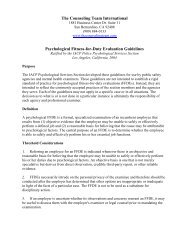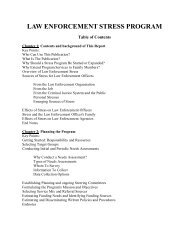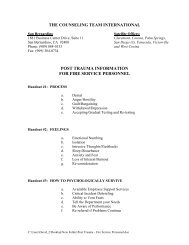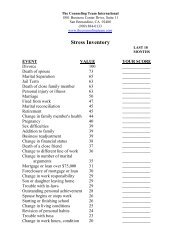ISSUES AND PRACTICES.pdf - The Counseling Team International
ISSUES AND PRACTICES.pdf - The Counseling Team International
ISSUES AND PRACTICES.pdf - The Counseling Team International
You also want an ePaper? Increase the reach of your titles
YUMPU automatically turns print PDFs into web optimized ePapers that Google loves.
almost the entire day) or more stressful (because every inmate is a potential time bomb). <strong>The</strong>evidence regarding stress levels associated with working in direct supervision facilities issimilarly inconsistent.<strong>The</strong> apparent stresses of a specific post or assignment may be offset by its perceived benefits.For example, tower duty may be boring but valued because it involves little or no inmatecontact.[d] All 13 officers posted to the North Infirmary Command on Rikers Island andGoldwater Hospital on Roosevelt Island in New York City for inmates with AIDS saw theassignment as a good one because it was not a prison setting, there were no captains or deputywardens supervising them on the wards, the inmates were usually more manageable than thegeneral population, the pay was good, and no one else wanted the position-the officers did nothave to play politics to get or keep it.[e]Still other conditions can influence stress levels. Officers who work in rural settings may berelated to or personally know other staff--or inmates--which can lead to concerns about privacy.Inmates in jails may present different problems for correctional officers than prison inmatesbecause so many jail detainees have just come into the facility right off the streets. In addition,rapid turnover in jails creates its own set of stresses: While correctional officers must not onlyestablish their authority and make clear the ground rules to a constantly changing population,they are at the same time frequently deprived of the satisfaction of seeing inmates improve theirlot through the educational, religious, vocational, and other programs prisons can offer theirlonger term inmates.Studies that have attempted to determine whether officers' stress levels are associated with lengthof time on the job, educational level, race, and gender have produced inconsistent findings.Notesa. Huckabee, R.G., "Stress in Corrections: An Overview of the Issues," Journal of CriminalJustice, 20 (5) (1992): 479-486.b. See, for example, Van Voorhis, P., F.T. Cullen, B.G. Link, and N.T. Wolfer, "Impact of Raceand Gender on Corrections Officers: Orientation to the Integrated Environment," Journal ofResearch in Crime and Delinquency 28 (4) (1991): 472-500; and Cullen, F.T., B.G. Link, N.T.Wolfe, and J. Frank, "<strong>The</strong> Social Dimension of Correctional Officer Stress," Justice Quarterly2 (4) (1985): 505-533.c. Lasky, G.L., and B.C. Gordon, "Occupational Stressors among Federal Correctional OfficersWorking in Different Security Levels," Criminal Justice and Behavior 13 (3) (1986): 317-327.d. Grossi, E.L., T.J. Keil, and G.F. Vito, "Surviving 'the Joint': Mitigating Factors of CorrectionalOfficer Stress," Journal of Crime and Justice 19 (2) (1996): 103-120.
















